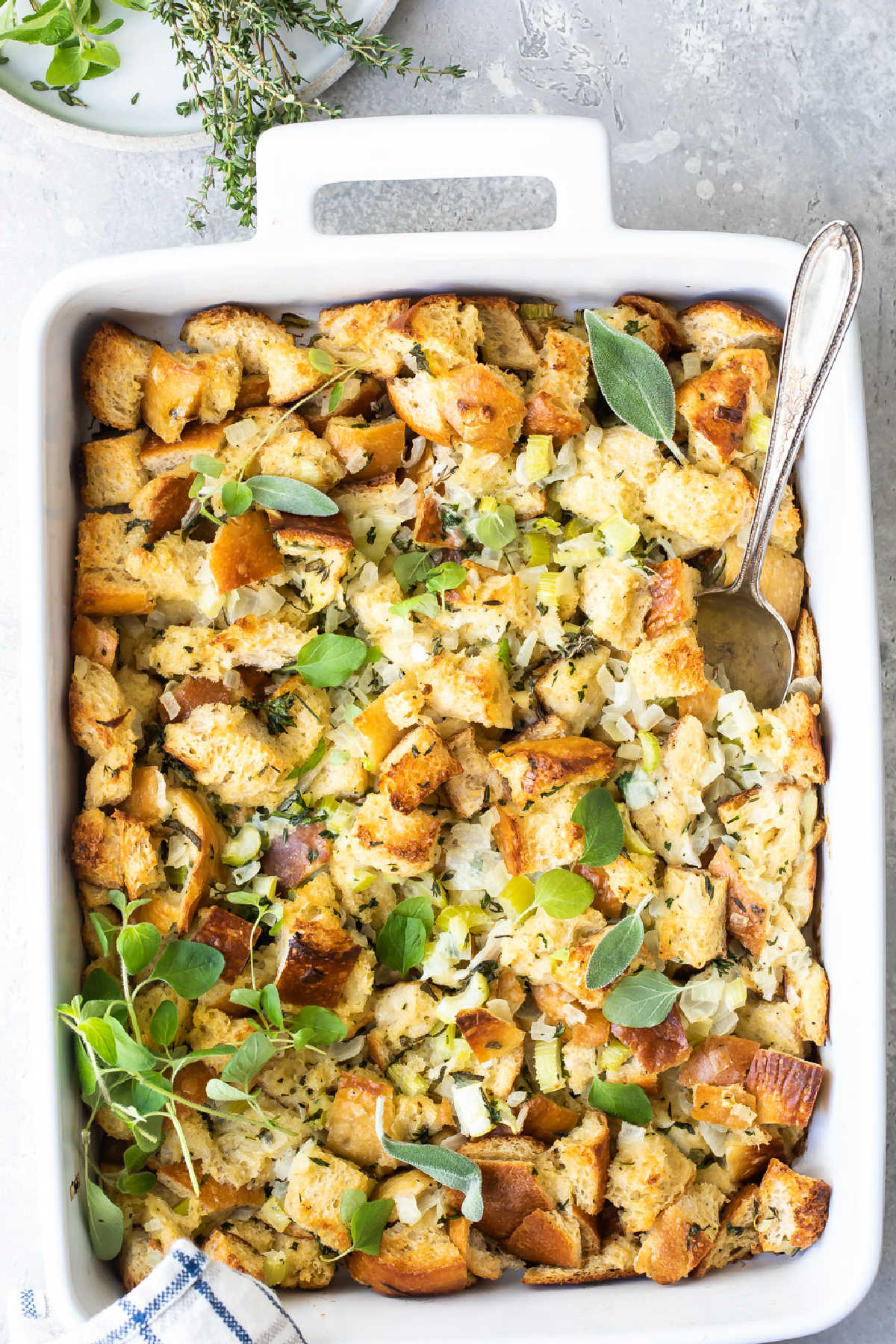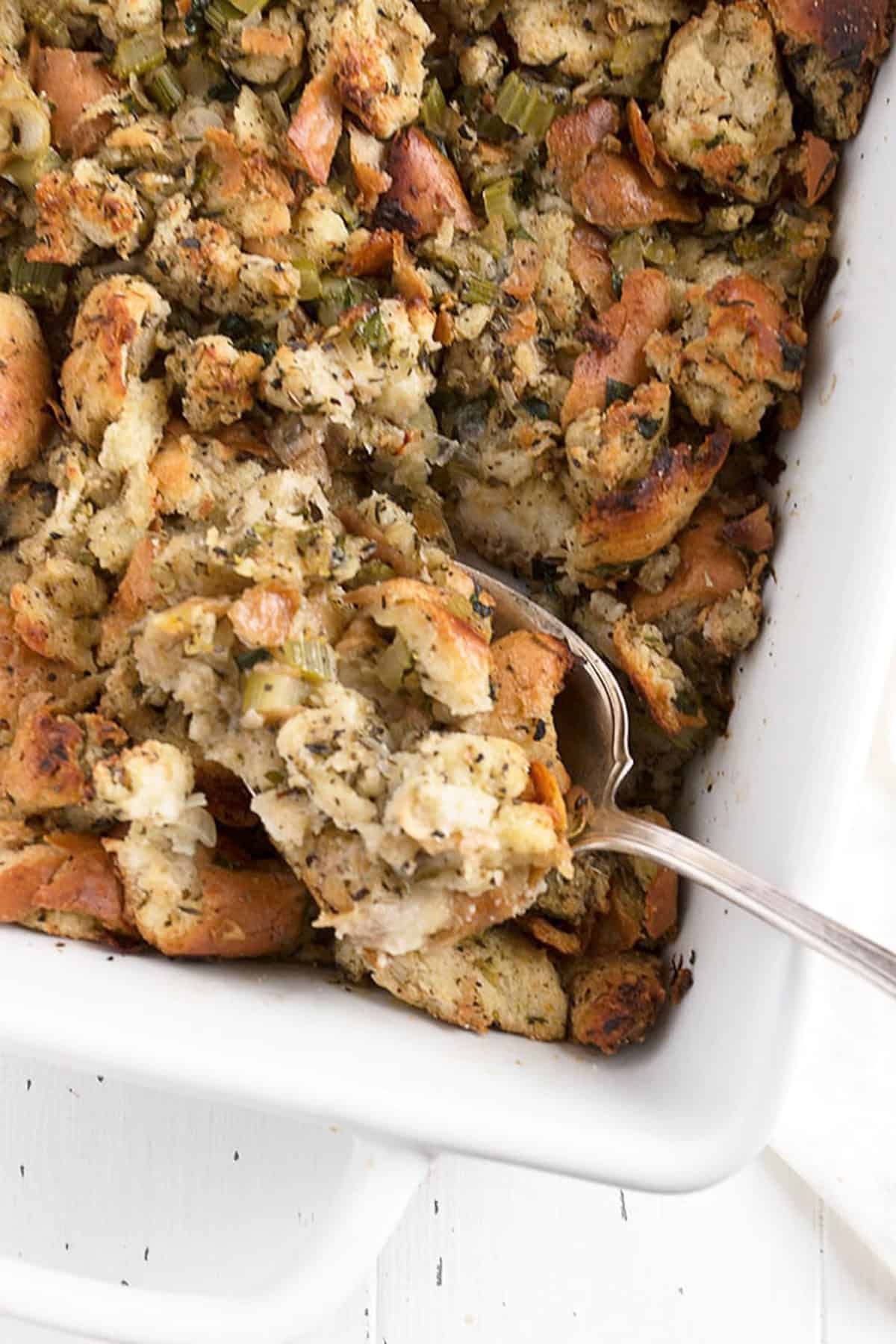As a professional chef, I understand the importance of achieving the perfect balance of flavors and textures in every dish. And when it comes to one of the most beloved Thanksgiving classics – stuffing, or dressing as some may call it – there’s no room for compromise. The secret to a mouthwatering stuffing lies not only in the choice of ingredients, but also in the cooking technique. So, if you’ve ever wondered how long to bake stuffing to achieve that golden, crispy top while keeping the inside moist and flavorful, you’ve come to the right place. In this guide, I will walk you through the essential steps and share my expert tips to help you master the art of baking stuffing to perfection. Get ready to elevate your holiday feast to a whole new level with a stuffing that will leave your guests begging for more. Let’s dive in!
How Long to Bake Stuffing: A Delicious and Easy Recipe
Get ready to impress your family and friends with a mouthwatering stuffing recipe that will have them begging for seconds. Baking stuffing is a classic way to achieve a crispy golden top and perfectly cooked center. In this recipe, we will guide you through the process of making a flavorful stuffing and exactly how long you should bake it for optimal results.
Ingredients:
– 8 cups day-old bread, cubed
– 1/2 cup unsalted butter
– 1 large onion, diced
– 2 celery stalks, diced
– 2 cloves garlic, minced
– 1 teaspoon dried thyme
– 1 teaspoon dried sage
– 1/2 teaspoon dried rosemary
– 1/2 teaspoon salt
– 1/4 teaspoon black pepper
– 2 cups chicken or vegetable broth
– 2 large eggs, lightly beaten
– Fresh parsley, for garnish (optional)
General Information:
– Difficulty: Easy to Medium
– Preparation Time: 20 minutes
– Cooking Time: 45 minutes
– Total Time: 1 hour 5 minutes
Instructions:
Step 1: Prepare the Bread and Preheat the Oven
First, you’ll need to preheat your oven to 350°F (175°C). This will ensure that the stuffing bakes evenly and achieves a nice golden crust. While the oven preheats, take your day-old bread and cut it into cubes. You want them to be around 1-inch in size for the perfect texture. Spread the bread cubes out on a baking sheet and toast them in the preheated oven for about 10 minutes, or until they are dry but not browned. Set aside.
Step 2: Sauté the Aromatics
In a large skillet, melt the butter over medium heat. Add the diced onion and celery, along with the minced garlic. Sauté until the vegetables become tender and fragrant, about 5 minutes. This will add depth of flavor to your stuffing.
Step 3: Season and Combine
Once the vegetables are cooked, sprinkle in the dried thyme, sage, rosemary, salt, and black pepper. Stir everything together to distribute the seasonings evenly. Remove the skillet from the heat and set it aside to cool slightly.
In a large mixing bowl, combine the toasted bread cubes with the vegetable mixture. Stir gently to incorporate the ingredients. Be careful not to overmix, as this can lead to a dense stuffing.
Step 4: Add the Liquid
Slowly pour the chicken or vegetable broth over the bread mixture, making sure to moisten all the cubes. The amount of liquid you need may vary slightly depending on the type of bread you are using. The bread should be thoroughly moistened but not soggy. Let the mixture sit for a few minutes to allow the bread to absorb the liquid.
Step 5: Bind It Together
Beat the eggs lightly in a separate bowl, then pour them over the stuffing mixture. The eggs will act as a binder and help hold the stuffing together during baking. Gently fold the eggs into the mixture until everything is well combined.
Step 6: Bake to Perfection
Transfer the stuffing mixture to a greased baking dish, spreading it out evenly. Cover the dish with aluminum foil, ensuring it is tightly sealed around the edges. This will help the stuffing retain moisture during the initial baking period.
Place the dish in the preheated oven and bake for 30 minutes. After this time, remove the foil and continue baking for an additional 15 minutes, or until the top of the stuffing is golden brown and crispy. This will give the stuffing a delightful crunch while keeping the center moist and tender.
Step 7: Garnish and Serve
Once the stuffing is baked to perfection, remove it from the oven and let it cool for a few minutes. Garnish with fresh parsley, if desired, for an extra touch of freshness and color. Serve warm as a delicious side dish alongside roasted turkey, chicken, or your favorite holiday meal.
Now that you know exactly how long to bake stuffing, you can confidently prepare this crowd-pleasing dish for any occasion. Remember to enjoy the process and have fun experimenting with different herbs and flavors to make it your own. Happy cooking!
Important Things to Keep in Mind When Making This “How Long to Bake Stuffing” Recipe
When it comes to holiday meals, stuffing is an absolute must-have. It’s the perfect accompaniment to a succulent roasted turkey or a juicy ham, and it adds that comforting, flavorful touch to any festive feast. While making stuffing may seem like a breeze, there are a few key things to keep in mind to ensure that it turns out perfectly every time. From the moisture level to the cooking time, here are some important tips for how long to bake stuffing that will help you create a delectable dish that your guests will rave about.
1. Consider the Moisture Level of the Stuffing Mixture
Before you determine the baking time for your stuffing, it’s crucial to assess the moisture level in the mixture. If your stuffing is on the drier side, it may require a longer bake time to ensure that it doesn’t turn out dry and crumbly. On the other hand, if your stuffing is moist, it will require a shorter baking period to prevent it from becoming mushy. The key is to strike the perfect balance of moistness, ensuring a stuffing that is delightfully soft and fluffy.
2. Take Into Account the Type of Bread Used
The type of bread you use in your stuffing can greatly affect the baking time. Dense bread, such as sourdough or rye, will require a longer bake time to allow the moisture to penetrate and soften the bread. On the other hand, lighter and fluffier bread, like white or French bread, will bake more quickly. It’s important to be aware of the bread’s texture and adjust the cooking time accordingly. Additionally, consider toasting the bread cubes before mixing them with the other ingredients. This step will help prevent a soggy texture and create a desirable crispy exterior.
3. Adjust the Cooking Time Based on the Stuffing Placement
The placement of your stuffing can play a significant role in determining the ideal cooking time. If you choose to stuff your bird, it will take longer for the stuffing to cook since it needs to reach a safe internal temperature of 165°F (74°C). This method can result in a wonderfully flavorful stuffing with all the delicious juices from the bird, but it will require additional time in the oven. On the other hand, if you bake the stuffing separately in a casserole dish, it will cook faster, achieving a crispy golden top. Adjust your cooking time accordingly to ensure a perfectly cooked stuffing, depending on whether you stuff your bird or bake it on its own.
4. Always Test for Doneness and Adjust as Needed
When it comes to determining the perfect cooking time for your stuffing, rely on your senses and a trusty thermometer. After the recommended baking time, check the color and texture of the stuffing and insert a thermometer to ensure it reaches the appropriate temperature. If your stuffing appears pale and not yet fully cooked, continue baking for another 5-10 minutes and check again. Conversely, if the stuffing is already golden brown and has reached the desired temperature, remove it from the oven to prevent any burning. Remember that the oven temperature and individual preferences can vary, so it’s important to use visual and temperature cues to achieve the ideal result.
Creating a memorable and delicious stuffing is an essential part of any festive meal. By keeping these important tips in mind, you can confidently determine the ideal baking time for your stuffing, ensuring that it turns out perfectly moist and flavorful. Whether you stuff your bird or bake it separately, choose the right bread, and use your senses to guide you along the way. With these tips, you’ll be well on your way to creating a stuffing that will have your guests coming back for seconds and begging for your recipe.
Frequently Asked Questions
Welcome to our Frequently Asked Questions section, where we provide answers to some common questions about baking stuffing. Whether you’re a seasoned cook or a beginner in the kitchen, we’ve got you covered. Read on to find answers to your burning questions about how long to bake stuffing!
1. What’s the ideal baking time for stuffing?
The ideal baking time for stuffing depends on various factors, such as the recipe, oven temperature, and stuffing ingredients. In general, most stuffing recipes recommend baking for around 30 to 45 minutes.
However, it’s crucial to check the internal temperature of the stuffing to ensure it’s fully cooked. The stuffing should reach an internal temperature of 165°F (74°C) to kill any harmful bacteria.
2. Can I adjust the baking time for a crispier stuffing?
Absolutely! If you prefer a crispier stuffing, you can adjust the baking time accordingly. To achieve a crispier texture, try baking the stuffing for a few extra minutes beyond the recommended time in the recipe.
Keep an eye on the stuffing as it bakes, as cooking times can vary based on personal preference and different ovens. The key is to monitor the stuffing’s color and texture, ensuring that it turns golden brown and has a crisp top layer to your liking.
3. Should I cover the stuffing while baking?
Whether you should cover the stuffing while baking depends on the recipe and desired outcome. It’s common for stuffing recipes to be baked uncovered. This helps to achieve a crispy top layer and browned edges.
However, if you notice that the top layer of the stuffing is browning too quickly or becoming too dry, you can cover it with foil for a portion of the baking time. This will help retain moisture and prevent burning.
4. Can I prepare stuffing ahead of time and bake it later?
Absolutely! Preparing stuffing ahead of time and baking it later is a great time-saving method. You can make the stuffing mixture according to the recipe instructions and refrigerate it until you’re ready to bake.
When you’re ready to bake the stuffing, remove it from the refrigerator, let it come to room temperature for about 30 minutes, and then proceed with the baking instructions in the recipe. Adjust the baking time slightly if necessary, as chilled stuffing may require a few extra minutes in the oven.
5. How do I know if the stuffing is fully cooked?
One way to determine if the stuffing is fully cooked is by checking its internal temperature. The stuffing should reach an internal temperature of 165°F (74°C) before it’s considered safe to eat.
Additionally, the top layer of the stuffing should be golden brown, and the edges should appear crisp. Use a fork to test the texture and make sure it’s not overly soggy. If the stuffing meets these criteria, it’s likely fully cooked and ready to be enjoyed!

